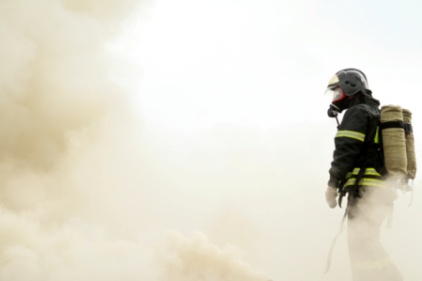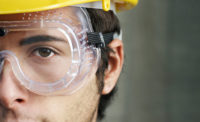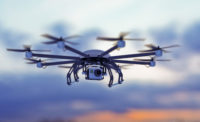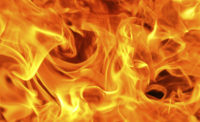 After the structural collapse of a large building, emergency responders and support personnel are often exposed to hazardous agents and conditions. These workers are at high risk of injury and illness at such a site. Described below are common eye hazards and injuries that can occur during these operations and recommendations for protective eye gear, first aid, and steps for preventing eye injuries.
After the structural collapse of a large building, emergency responders and support personnel are often exposed to hazardous agents and conditions. These workers are at high risk of injury and illness at such a site. Described below are common eye hazards and injuries that can occur during these operations and recommendations for protective eye gear, first aid, and steps for preventing eye injuries.
All safety eyewear should comply with the American National Standards Institute Occupational and Educational Personal Eye and Face Protection Devices Standard Z87.1
Common Eye Hazards
The most common eye hazards faced by emergency workers at the structural collapse of a large building are the following:
- Dust, concrete, and metal particles
- Falling or shifting debris, building materials, and glass
- Smoke and noxious or poisonous gases
- Chemicals (acids, bases, fuels, solvents, lime, and wet or dry cement powder)
- Cutting or welding light and electrical arcing
- Thermal hazards and fires
- Bloodborne pathogens (hepatitis or HIV) from blood, body fluids, and human remains
Common Injuries
Injuries commonly suffered by emergency response and recovery workers at a structural collapse include the following:
- Corneal abrasions and conjunctivitis (red eyes)
- Concrete or metal particles or slivers embedded in the eye
- Chemical splashes or burns
- Welder’s flash
- Eyeball laceration
- Facial contusions and black eyes
Recommended Types of Eye Protection
Before selecting appropriate eye protection for emergency workers at a site, assess the conditions and hazards and follow these recommendations:
- At a minimum, wear safety glasses with side protection.
- Wear goggles when more protection is needed.
- Consider using hybrid eye safety products with the comfort of glasses, the enclosure of goggles, and better breathability.
- Add a faceshield over glasses or goggles for even greater protection.
- Use a full-facepiece respirator for the best overall protection.
- When cutting or welding, use a welding helmet, goggles, or welding respirator with the appropriate lens shade.
- Make sure that cutter’s and welder’s helpers, other workers, and bystanders are protected from the light and sparks coming from torch cutting or welding.
Consider each of the following types of eyewear when selecting one for emergency workers at a structural collapse site:
1. Safety glasses, including hybrid safety glasses or goggles—minimum protection required
Wear safety glasses for general working conditions when there is some risk of exposure to dust, chips, and flying particles. Use safety glasses that have the following:
- Side protection (such as side shields or wrap-around lenses)
- Treatment to prevent fogging
- A retainer to keep the glasses tight to the face or hanging from the neck when not in use
- For added protection, use one of these types of glasses:
- Hybrid glasses with foam or rubber around the lenses to protect against dust and flying particles (these protect workers better than conventional safety glasses with side
- shields only).
- Wrap-around hybrid safety glasses that convert to goggles with a soft plastic or rubber face seal for better peripheral vision than conventional goggles.
- Take these precautions if you use safety glasses with prescription lenses:
- Use polycarbonate or Trivex® lenses for prescription safety glasses. These lenses provide the best impact protection in prescription safety glasses.
- Make sure that new safety glasses with polycarbonate lenses are hard coated to reduce scratching.
- Make sure that you are using ANSI Z87.1-compliant safety eye protection.
- Do not use prescription safety lenses with tempered glass or acrylic plastic lenses for protection from high impact unless they are covered by goggles or a face shield.
- If you wear prescription safety glasses without goggles, use glasses with side shields.
2. Goggles—better protection
Goggles are needed to protect workers from high impacts, dusty environments, chemical splashes, and torch cutting or welding light (see item 5 below for welding protection). Consider the following characteristics when selecting goggles:
- Use goggles with indirect venting to protect workers from splashes or fine dust. Use goggles with direct venting for less fogging when working with large particles.
- Use safety goggles designed with high air flow, minimum fogging, and maximum particle and splash protection (for example, ski-type goggles).
- In dusty environments, wear tight-fitting goggles over normal streetwear glasses, contact lenses, or prescription safety glasses.
- If you wear contact lenses, wear tight-fitting goggles or a full-facepiece respirator to avoid corneal abrasions in dusty areas.
3. Face shields—additional protection
Use face shields to protect workers from high-impact hazards that may be present during chipping and grinding operations. Use full-face protection to prevent contact with chemical or blood-borne hazards that may be sprayed or splashed onto the face. Also do the following when selecting and using face shields:
- Use face shields that are tinted or metal-coated for heat and splatter protection.
- Always wear safety glasses or goggles under a face shield, since the curve of the face shield directs particles or chemicals from the side into the eyes.
4. Full-facepiece respirators—best eye protection from dust, chemicals, and smoke
When respiratory protection is required, use full-facepiece respirators for the best eye protection against dust, chemicals, and smoke.
Note that not all facepieces are Z87-compliant for impact protection.
Full-facepiece respirators do not seal properly over streetwear glasses or safety glasses. Therefore, if you wear glasses and must wear a respirator, use prescription inserts designed to be compatible with a respirator and approved for use with your specific respirator.
If a worker wears a half-mask respirator, select the proper eye protection and make sure that
— the half mask does not interfere with the proper positioning of the eye protection, and
— the eye protection does not affect the fit of the respirator.
5. Welding helmet, goggles, faceshields, and welding respirators
Exposure to cutting or welding light can cause severe burns to the eyes and surrounding tissue (welder’s flash). The lenses for protection from cutting or welding light must be marked with the shade number—1.5 through 14 (the darkest).
Protect cutter’s or welders’ eyes with a helmet, goggles, faceshield, or welding respirator equipped with lenses of the correct shade number.
Always wear safety glasses or goggles under a welding helmet or faceshield to protect workers from particles.
Also protect the eyes of the cutter’s or welder’s helper and bystanders with lenses designed to protect against cutting or welding light.
Use the darkest shade of lens possible:
Torch soldering. . . . . . . . . . . . . . . . . . . 1.5–3
Torch brazing/cutting . . . . . . . . . . . . . . 3–6
Gas welding . . . . . . . . . . . . . . . . . . . . . 4–8
Electric arc welding. . . . . . . . . . . . . . . . 10–14
Use ANSI Z136 eye protection for laser light hazards (not Z87).
First Aid for Eye Injuries
Specks in the Eye
- Do not rub the eye.
- Flush the eye with large amounts of water.
- See a doctor if the speck does not wash out or if pain or redness continues.
Cuts, Punctures, and Foreign Objects in the Eye
- Do not wash out the eye.
- Do not try to remove a foreign object stuck in the eye.
- Seek immediate medical attention.
Chemical Burns
- Immediately flush the eye with water or any drinkable liquid. Open the eye as wide as possible. Continue flushing for at least 15 minutes. For caustic or basic solutions, continue
- flushing while on the way to medical care.
- If a contact lens is in the eye, begin flushing over the lens immediately. Flushing may dislodge the lens.
- Seek immediate medical attention.
Blows to the Eye
- Apply a cold compress without pressure, or tape crushed ice in a plastic bag to the forehead and allow it to rest gently on the injured eye.
- Seek immediate medical attention if pain continues, if vision is reduced, or if blood or discoloration appears in the eye.






